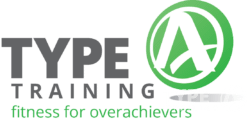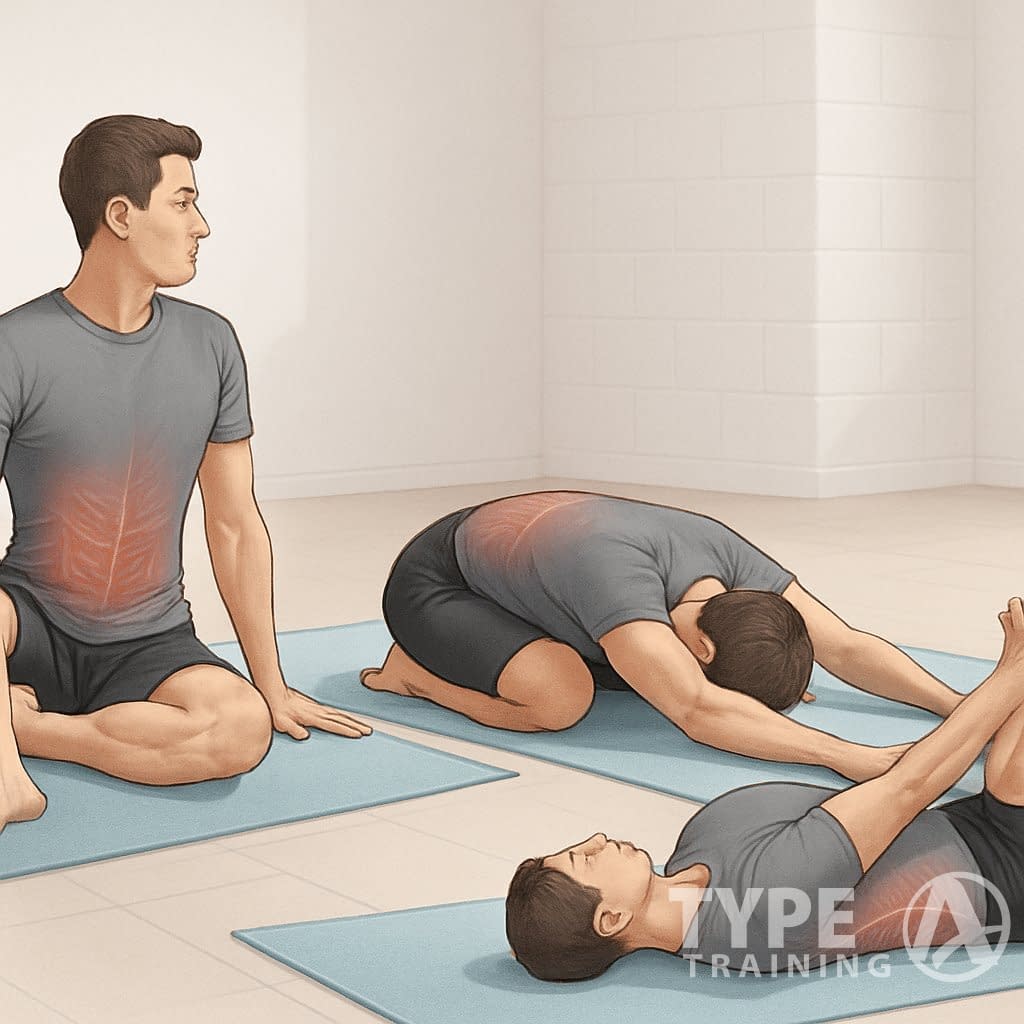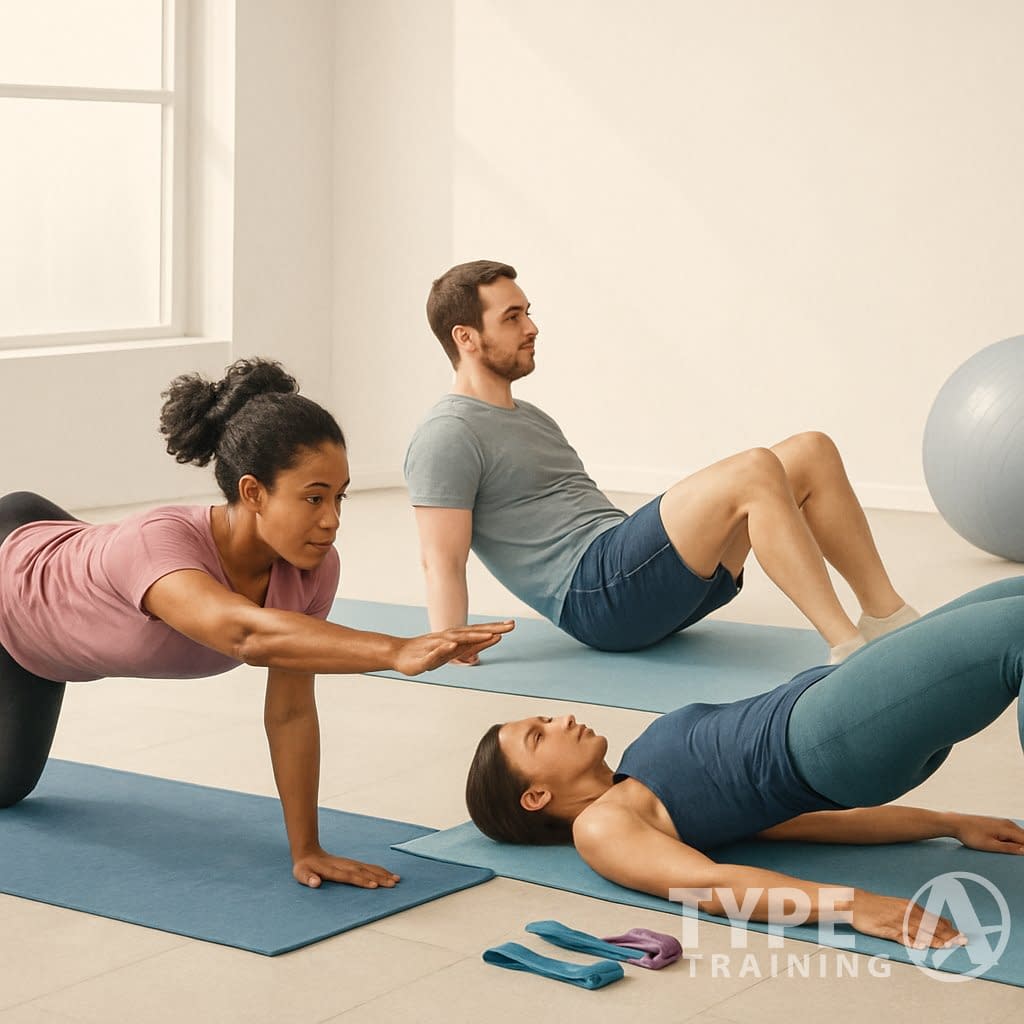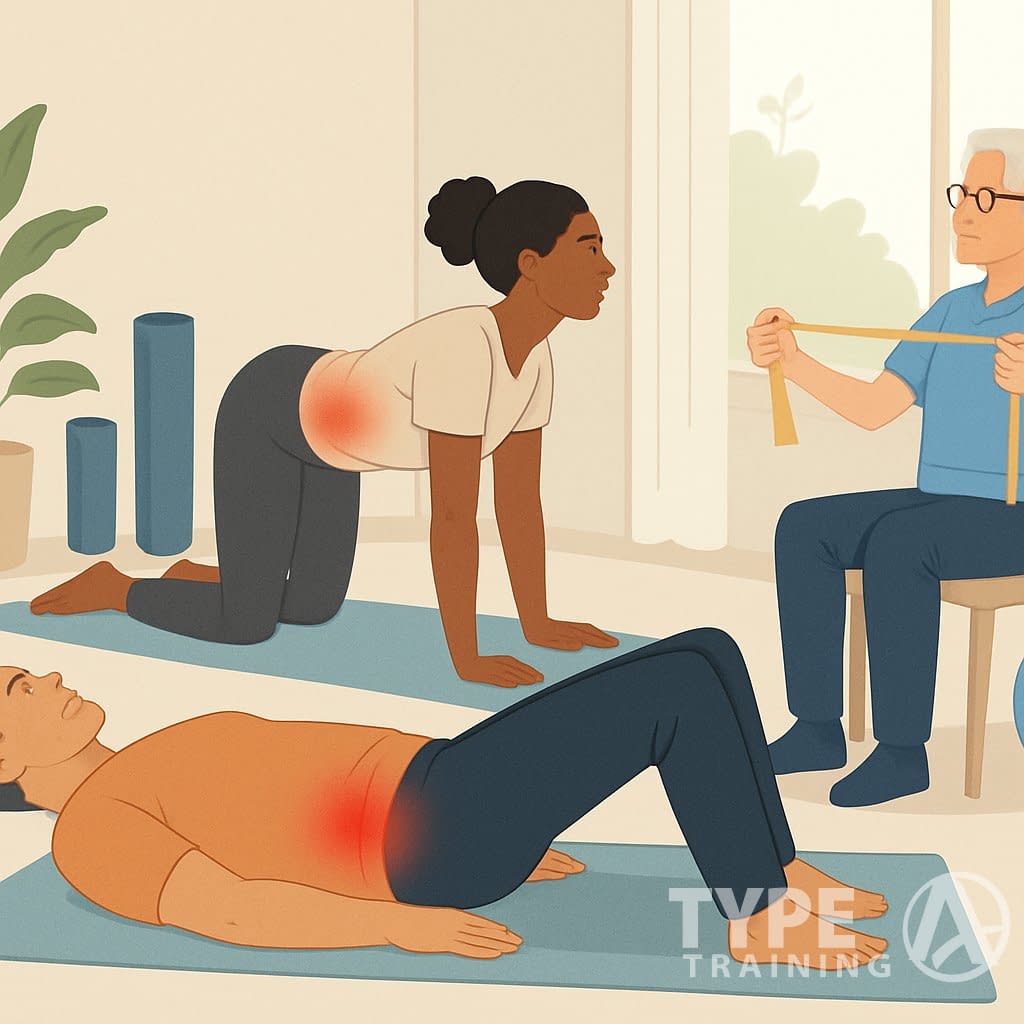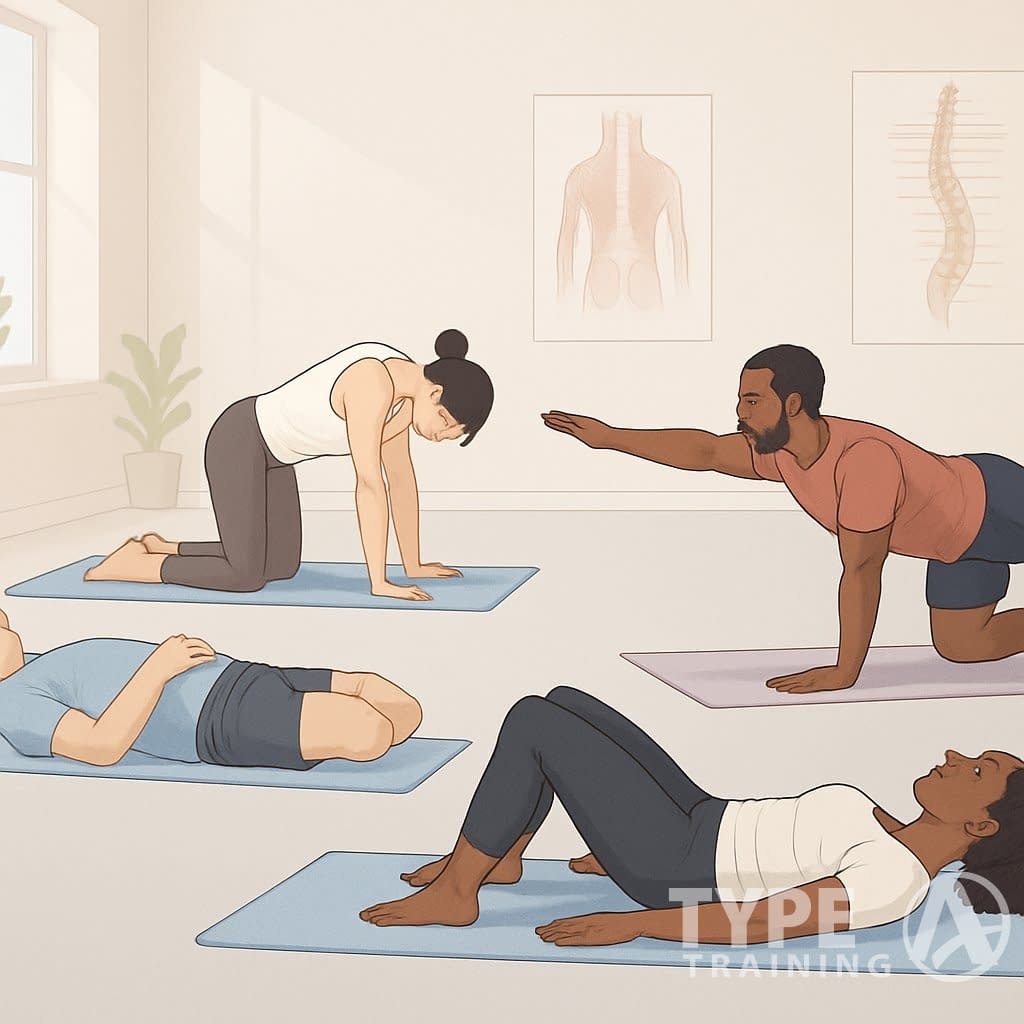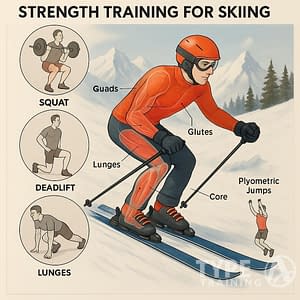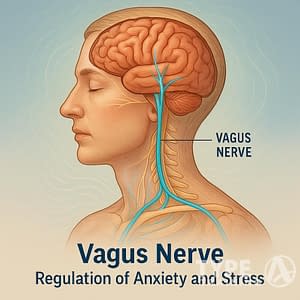Lower back pain is a problem for millions, especially for Manhattan professionals who spend endless hours hunched over desks or packed into subway cars. Whether you’re dodging crowds in SoHo or hauling groceries up a Chelsea walk-up, a cranky lower back can turn the simplest things into a real hassle.
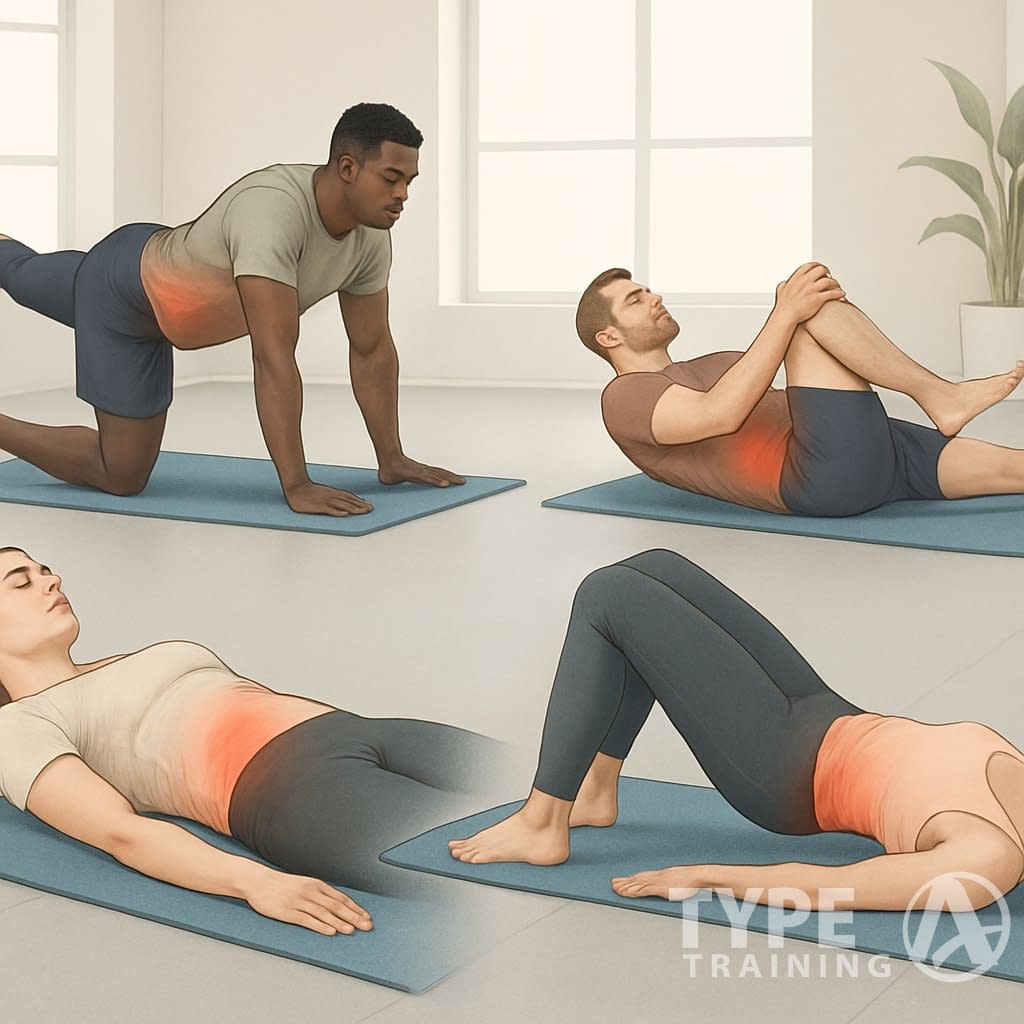
The right corrective exercises for lower back pain can actually tackle the root causes of lower back pain. They help by fixing muscle imbalances, boosting mobility, and building up the muscles that keep your spine in check through corrective exercises for lower back pain.
Unlike those quick fixes that just mask the pain, corrective exercises for lower back pain follow a specific approach. They focus on stretching muscles that are too tight and waking up the ones that are slacking through corrective exercises for lower back pain.
Popular posts:
This guide covers stretching techniques, strengthening moves, and easy ways to fit these exercises into your busy NYC life. If you’ve got tight hip flexors from sitting too long or weak glutes, you’ll finally get some real answers for lasting relief.
Key Takeaways
- Corrective exercises fix muscle imbalances and movement patterns that actually cause lower back pain, not just the symptoms.
- Stretching tight muscles and strengthening weak ones is the best combo for relief.
- Doing these exercises daily can keep future back pain at bay and help you move better overall.
Understanding Lower Back Pain and Exercise
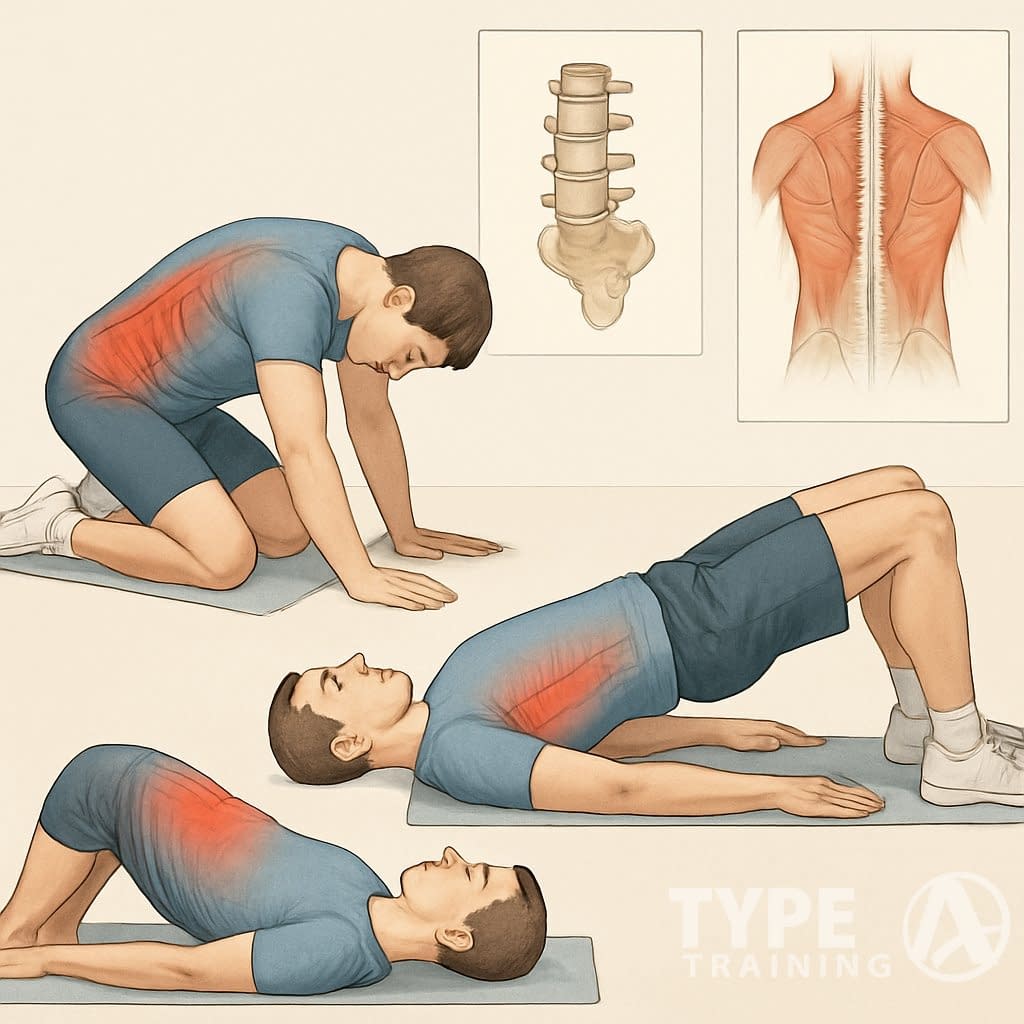
Lower back pain is way too common—39% of adults deal with it, if you can believe the surveys. Exercise is key for both treating and dodging lower back pain because it targets muscle imbalances, improves how you move, and builds up support around your spine.
Incorporating corrective exercises for lower back pain into your routine can greatly enhance recovery.
Common Causes of Lower Back Pain
Lower back pain doesn’t usually have just one cause. It’s a mix of things working together.
Muscle imbalances are at the top of the list, especially for folks spending hours at a desk.
Long days sitting can tighten up your hip flexors. That tips your pelvis forward, stretching out your glutes and messing with your spine’s curve.
Your lower back muscles then try to pick up the slack for your lazy glutes, which just leads to soreness and constant fatigue.
Decreased mobility in your hips, upper back, or ankles forces your lower back to move more than it’s supposed to. That extra movement puts stress right where you don’t want it.
Other culprits include:
- Disc problems and joint issues
- Spinal instability from a weak core
- Bad posture from commuting or desk work
- NYC lifestyle factors like stress and barely moving all day
If you work in Midtown or the Upper East Side, the combo of subway rides and desk jobs is just asking for back problems. Your body gets used to these positions, and that leads straight to pain.
Benefits of Corrective Exercise
Corrective exercise is all about fixing the real issues behind your lower back pain. Research shows stretching and strengthening can keep back pain from coming back.
Engaging in corrective exercises for lower back pain is essential for long-term wellness.
The main win? Better muscle balance. Loosen up the tight muscles, strengthen the weak ones, and your body starts moving the way it should. That means less pressure on your lower back.
Regular participation in corrective exercises for lower back pain can lead to better posture.
More mobility in your hips and upper back lets your lower back chill out and stop moving too much. When your body moves better, your back doesn’t have to do all the work.
Implementing corrective exercises for lower back pain in your daily activities can help you avoid future discomfort.
A stronger core is like your own built-in back brace. It keeps your spine steady, no matter what you’re doing.
Improved movement patterns make everyday stuff—walking in Central Park, hauling groceries in SoHo—a whole lot easier and safer.
Busy New Yorkers love that these exercises can fit into a packed schedule. Some folks in Chelsea and the Financial District say they notice big changes in just 4-6 weeks.
Precautions Before Starting a Routine
Before you jump in, it’s worth thinking about your current situation. Always check with your doctor before starting any exercise program, especially if your back pain is sticking around.
After your routine, consider additional corrective exercises for lower back pain to maximize effectiveness.
If you feel sharp pain, numbness, or tingling during any exercise, stop right away. Those are red flags you shouldn’t ignore.
Skip these moves if you want to avoid making things worse:
- Loaded spinal exercises like back squats
- Big back arching moves like supermans
- Heavy forward bending
- Side bending with weights
Go slow. Start with the basics and build up. If you’ve been hurting for a while, your body needs time to adjust.
Focus on good form, not how intense it feels. Bad technique is just going to keep you stuck.
Consider working with a Movement Assessment NYC pro or a Corrective Exercise Specialist Manhattan. Personalized help can make a huge difference, and plenty of folks in Tribeca and the West Village swear by it.
Pay attention to your body. Some soreness is normal, but sharp pain or things getting worse means it’s time to tweak your plan.
Essential Stretching Techniques for Relief
Here are three go-to stretches for the muscles that usually cause lower back pain. Each one helps you get back some flexibility and eases the tension that builds up from long hours at the desk.
Knee to Chest Stretch
This gentle stretch targets your lower back muscles and hip flexors. It’s a lifesaver after hours at the computer.
How to do it:
- Lie on your back, knees bent.
- Pull one knee toward your chest with both hands.
- Hold for 15-30 seconds.
- Switch legs and repeat.
The knee to chest stretch feels especially good after a long subway ride. If your apartment’s tiny, just do it on your bed.
Why it’s great:
- Loosens up after sitting all day
- Helps hips move better
- Takes pressure off your spine
Don’t force it. The stretch should feel good, not painful.
Lower Back Twist
The trunk rotation stretch gets your spine moving again, which is super important if you’re always carrying heavy bags.
How to do it:
-
- Lie on your back with knees bent.
This is a perfect moment to think about how corrective exercises for lower back pain can ease your discomfort.
- Keep your shoulders flat.
- Let both knees drop to one side.
- Hold 5-10 seconds.
- Bring them back to center and switch sides.
This stretch hits the muscles between your ribs and pelvis. It’s a solid pick for anyone twisting around at work.
A couple tips:
- Move slow and easy
- Don’t push the twist
- Stop if it hurts
It should feel like a nice release, not a strain.
Chair Stretch
This one’s made for the office crowd. You can do it right at your desk—no need to change clothes.
How to do it:
- Sit up tall.
- Put both hands on your desk or a counter.
- Step your feet back and keep your arms straight.
- Make a straight line from hands to hips.
- Hold 5-10 seconds.
This move is kind of like child’s pose but desk-friendly. It stretches the whole back side of your body.
Why it’s perfect for work:
- No gear needed
- Works in work clothes
- Quick relief from desk tension
It hits the tight spots from slouching and rounded shoulders—NYC office classics.
Effective Strengthening Exercises
Building core stability and back strength is the main way to fight off lower back pain, especially when NYC life has you sitting all day. These exercises target the weak spots that come from too much sitting and not enough moving.
Including corrective exercises for lower back pain helps maintain core stability.
Bird-Dog Exercise
The bird-dog is a classic for getting your deep core and lower back working together. It’s great for posture and keeps your spine steady during long days at the office.
Starting position:
-
- On hands and knees
The bird-dog is one of the best corrective exercises for lower back pain as it strengthens your core.
- Wrists under shoulders, knees under hips
- Back flat
How to do it:
Reach your right arm forward and your left leg back. Hold for 5-10 seconds, keeping your hips level. Switch sides.
What it helps:
- Strengthens the muscles along your spine
- Improves how your upper and lower body work together
- Boosts your balance
Start with 5 reps per side. Work up to 10-15 as you get stronger. Lots of lower back exercises use this same “build as you go” idea.
Wall Sits
Wall sits are awesome for your glutes and quads, and they support your lower back. They’re quick, effective, and you can do them almost anywhere.
How to set up:
Stand with your back to a wall. Walk your feet out about two feet. Slide down until your thighs are parallel to the floor.
Form tips:
Keep knees at 90 degrees, back flat against the wall, feet shoulder-width.
How to progress:
Start with 20-30 seconds. Try for 60 seconds as you get better. Rest about 30 seconds between sets.
Wall sits fight tight hip flexors and wake up your glutes—exactly what you need after a day in a chair.
Abdominal Crunches
Modified crunches work your core without putting your lower back in a bad spot. These moves help keep your spine stable, which is huge for anyone stuck commuting or at a desk.
Incorporating corrective exercises for lower back pain into your routine can prevent future issues.
How to do it:
Lie on your back, knees bent, feet flat. Hands behind your head (don’t lace your fingers). Lift your shoulder blades up, keeping your lower back pressed down.
A few pointers:
- Breathe out as you crunch up
- Lift your chest, not your neck
- Keep it slow and steady
How many:
Start with 2 sets of 10-15 reps. Bump it up to 3 sets of 20 as your core gets stronger. You’ll see similar moves in 15-minute back workouts.
Side Bend
Side bends work your quadratus lumborum and obliques—these muscles keep your spine stable from side to side. They’re a must if you’re always carrying a bag on one shoulder.
How to do it:
Stand with feet hip-width apart. Hold a light weight or even a water bottle in your right hand. Put your left hand on your hip.
Bend slowly to the right, letting the weight drop toward your knee. Feel the stretch on your left side. Use your core to come back up.
Safety tips:
- Keep shoulders facing forward
- No leaning forward or back
- Move slow and controlled
- Start light
Do 12-15 reps per side. This move is perfect for balancing out the one-sided habits we all pick up running around the city.
Incorporating Corrective Exercises Into Daily Life
Fitting corrective exercises into daily life isn’t exactly effortless, but it’s doable with some strategy. You’ll need a steady routine, a smart workspace, and a few lifestyle tweaks—especially if you’re hustling around Manhattan.
These moves help busy New Yorkers keep their spines happy, even with long commutes and packed schedules.
Safe Progression and Frequency
Start with just 5-10 minutes a day—don’t bite off more than you can chew. Ease into each exercise at a lighter intensity, then slowly ramp up as your body gets the hang of things.
Try basic stuff like knee-to-chest stretches each morning before heading to Penn Station or Grand Central. Once you’re comfortable, add a new exercise every week so your lower back gets stronger without feeling overloaded.
Frequency Guidelines:
- Week 1-2: 2-3 exercises, 5 minutes daily
- Week 3-4: 4-5 exercises, 8 minutes daily
- Week 5+: Full routine, 10-15 minutes daily
Pick times that actually work for you. Some folks in the Financial District swear by morning sessions, others prefer winding down with stretches after work.
Pay attention to your body. If you’re just a bit tired, that’s fine. But if you feel sharp pain, ease up or check in with a corrective exercise specialist in NYC.
Posture and Ergonomics
Your workspace can make or break your back, especially in those Manhattan high-rises. Keep your monitor at eye level—no craning your neck.
Desk Setup Essentials:
- Chair height: Feet flat, knees at 90 degrees
- Monitor distance: 20-24 inches from your eyes
- Keyboard position: Elbows bent at 90 degrees
- Lumbar support: Toss a small pillow or rolled towel behind your lower back
Take movement breaks every half hour. Stand up, grab some water, or do a quick hip flexor stretch at your desk.
Lots of Upper East Side and Midtown folks use standing desks part-time. Try switching between sitting and standing every couple of hours to give your lumbar spine a break.
If you’re not sure about your setup, consider an ergonomic assessment from someone who gets the whole NYC office scene.
Lifestyle Modifications for Long-Term Relief
Swap out some subway rides for a walk if you can. Maybe stroll from Union Square to SoHo or take the stairs in Chelsea buildings instead of the elevator.
Daily Movement Integration:
- Foam roll while watching TV in your Tribeca apartment
- Do floor bridges during commercials
- Practice posture exercises while waiting for the subway
- Stretch your hip flexors after climbing stairs in your walk-up
How you sleep matters too. If you’re a side sleeper, tuck a pillow between your knees; if you’re on your back, try one under your knees.
Get
Some Hell’s Kitchen locals swear by corrective exercise programs tailored to city life and their own movement quirks.
Find a neighbor or coworker to team up with if you both struggle with back pain. Checking in with someone else makes it way easier to stick with your routine.
Work With NYC’s Posture Correction Expert – Book Your Session
Frequently Asked Questions
Here’s a quick dive into common questions about corrective exercises for lower back pain. Let’s keep it practical—home routines, pro tips, and safe tweaks that fit the Manhattan lifestyle.
What are the most effective home-based exercises for alleviating lower back pain?
The best home exercises go after muscle imbalances from too much sitting (yeah, we’re looking at you, desk jobs). Pelvic tilts are a classic—they fire up your core and help your lower spine stay stable.
If you’re stuck commuting or driving, hip flexor stretches are a lifesaver. They undo that forward-tilted hip thing that makes your back ache.
Glute bridges are awesome for waking up lazy glutes. Lie down, squeeze those glutes, and lift your hips until your body’s in a nice straight line.
Bird dog exercises are great for dialing in core-back coordination. Start on all fours, reach out with one arm and the opposite leg, and keep your back neutral.
How can physiotherapy exercises address lower back pain and aid in rehabilitation?
Physiotherapy exercises follow a specific order to tackle the actual cause—not just the symptoms. Physical therapy for lower back pain has a solid track record for getting people back on their feet.
Usually, rehab starts with foam rolling tight spots like hip flexors and inner thighs. This is huge if you’re logging lots of meeting hours or have a jam-packed Financial District schedule.
A movement assessment helps pinpoint your unique imbalances. A Manhattan corrective exercise specialist can figure out if your pain comes from tight hips, weak glutes, or a wobbly spine.
Then you move on to strengthening. Start simple (think glute bridges), and work up to more challenging stuff like single-leg squats with rows that pull in more muscles.
Which gym exercises are recommended for strengthening the lower back and preventing pain?
Stick to gym moves that keep your spine neutral and build strength. Skip anything that puts too much weight on your back, like back squats, if you’re already hurting.
Resistance bands are a solid choice for safe strengthening. Try squat-to-row combos—they hit your legs and upper back, which helps fix that forward-head slump that comes from computer work.
Cable machines are great for controlled moves like lat pulldowns and rows. These help open up rounded shoulders from too much desk time.
Side planks target those side core muscles that keep your spine steady. Start on your knees if you need to, and work up to full planks as you get stronger.
Could you list the top three exercises that target lower back pain relief?
The knee-to-chest stretch is a go-to for instant relief. Pull both knees in until you feel a gentle stretch in your lower back—hold for about 30 seconds.
Cat-cow stretches loosen up your spine and fight off stiffness. This one’s a favorite for folks who spend a lot of time on their feet or dealing with city stress.
These corrective exercises for lower back pain are designed to be simple and effective.
Pelvic tilts work those deep core muscles and teach your body what good alignment feels like. Plus, they hardly take up any space—perfect for small NYC apartments.
What exercises should be avoided to prevent worsening of lower back pain?
Skip any move that hurts while you do it or after. Exercises that overload your spine, like supermans (lifting both arms and legs at the same time), can make things worse.
Consulting with a professional can provide you with the best corrective exercises for lower back pain.
Avoid loaded forward bends, especially if your back’s already acting up. Don’t round your spine while lifting weight.
High-impact stuff (like running on concrete in SoHo or Tribeca) can flare up your symptoms. Stick with walking or other low-impact options until you’re feeling better.
Twisting with weight is risky when you’re healing. Hold off on things like Russian twists or medicine ball throws until you know your back can handle it.
Avoiding certain movements during corrective exercises for lower back pain can prevent exacerbation of symptoms.
What type of exercise class is advisable for someone suffering from chronic lower back pain?
Gentle yoga classes that focus on alignment and core strength can really help manage chronic pain. Try to find studios in the West Village that care more about proper form than fancy poses.
Pilates is another solid choice for core strength. Instructors in Manhattan often offer small group sessions, and they’ll tweak exercises to fit your needs.
Water aerobics takes a lot of pressure off your joints while still giving you a workout. The water’s buoyancy supports your weight, so it’s easier to move on days when your back’s acting up.
Engaging in corrective exercises for lower back pain regularly can significantly lower your risk of injury.
Incorporating various corrective exercises for lower back pain is crucial for maintaining overall health.
